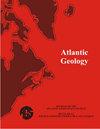Geological Association of Canada Newfoundland Section Abstracts: 2015 Spring Technical Meeting
IF 0.9
4区 地球科学
Q2 GEOLOGY
引用次数: 1
Abstract
The 2014 Spring Technical Meeting was once again held in the depths of the Newfoundland winter in the GEO The meeting featured a special session on Monday afternoon entitled “Offshore Petroleum Basins: A New Frontier” which covered a wide range of subjects related to offshore petroleum basins, including geology and geophysics, plate reconstruction, offshore engineering and environmental considerations In addition, general sessions (Monday morning and all day Tuesday) included papers on an eclectic range of topics, as is normally the case at these meetings. and the Question: Measuring the Depth The distribution of Ni-Mg-Fe in olivine is conventionally used to assess if sulfide saturation and segregation of a potentially economic sulfide liquid have occurred in a mafic intrusion. Despite the limited geochemical resolution of this traditional application, olivine multi-trace element studies have never been adopted to expand the geochemical sensitivity of olivine as tracer of multiple ore-forming processes.We present major and trace element data (Ca, Sc, Mg, Si, Ti, V, Cr, Mn, Fe, Co, Ni, Cu, Zn, Sr, Y, and Zr) that show informative geochemical variability in olivine from both barren and mineralized olivine-gabbro and troctolite lithologies in the Voisey’s Bay (VBI) and Pants Lake intrusions (PLI). Both intrusions have broadly similar lithologies and petrographic characteristics and are approximately coeval (1.34 Ga and 1.32 Ga, respectively) members of the Mesoproterozoic Nain Plutonic Suite. However, the VBI hosts a producing economic Ni-Cu-Co sulfide deposit, whereas in the PLI, although it displays evidence of Ni-Cu sulfide mineralization, a viable ore deposit has not yet been discovered.In general the olivine chemistry in the VBI varies systematically – more primitive (~Fo 77 , ~1,600 ppm Ni) in barren intervals, more evolved (~Fo 62 , ~800 ppm Ni) in mineralized sections – with a pronounced increase in especially Mn (+~7,000 can onshore be used to fingerprint distinct sediment sources show a range of Fe/Al and base-metal values from samples with hydrothermal signatures, indicated by high Fe/Al and base-metal values, to those with noticeable detrital input, indicated by lower Fe/Al and base-metal values. The Lemarchant exhalites have positive shale-normalized Eu anomalies (Eu/Eu* ≥ 1) and negative Ce anomalies (Ce/Ce* ≤1), as well as an Y/Ho ratio of ~27. These values suggest precipitation from reduced, high-temperature hydrothermal vent fluids with a short residence time within the plume and thus, a vent-proximal setting under oxidizing conditions. In-situ analyses of sulfides (euhedral and framboidal pyrite, anhedral chalcopyrite and pyrrhotite, and euhedral arsenopyrite) were determined by secondary ion mass spectroscopy (SIMS). δ34S values from -38 to +8‰ indicate the sulfides have a predominantly diagenetic-biogenic sulfur source and formed under open system conditions with abundant seawater sulfate present. The predominantly biogenic signatures in the sulfides that most of the sulfides in the mudstones formed during diagenesis and are not primary, hydrothermal sulfides. The Hammerdown Basalt separates two of the oldest tectonic constituents of the peri-Laurentian Western Notre Dame Bay volcanic belt. It forms a narrow map unit situated near the regional boundary between the Ordovician Catchers Pond Group and the Cambrian Lushs Bight Group on the southwestern part of the Springdale Peninsula. Picrobasalt, the the Hammerdown base metal-enriched suites of tholeiitic and subordinate calc-alkalic Such may be correlated mid-ocean transitional the partial of the sequence island crystal typifies the Long marine upper The producing Ming Mine is a Cu-Au volcanogenic massive-sulphide (VMS) deposit. It is located in the Cambrian-Ordovician Baie Verte Belt, host to numerous past producing Cu and Cu-Au VMS deposits. The deposit contains 3.65 Mt at 2.26 wt % Cu, 1.13 g/t Au, 6.78 g/t Ag, and 0.32 wt % Zn and is hosted by intermediate to felsic volcanic and volcaniclastic of the Early Ordovician (ca. 487 Ma) Pacquet Harbour Group, which is part of a regional mafic-dominated rock assemblage of boninitic to tholeiitic affinity. The deposit is characterized by elongated Cu-Au-Zn±Ag to semi-massive and the ore zones are separated to metres from each the Cu-rich pyrrhotite a chloritized located to 100 m below the main sulphide lens. Distinct alteration assemblages identified based on the distribution and relative abundance of specific alteration and minerals such as sericite, chlorite, and pyrite. in central-western along the southwestern boundary the Meelpaeg and Notre Dame subzones of The property includes three significant gold (Hilltop, Sure Shot, and Falls) and one drilled the Wood加拿大地质协会纽芬兰分会摘要:2015年春季技术会议
本文章由计算机程序翻译,如有差异,请以英文原文为准。
求助全文
约1分钟内获得全文
求助全文
来源期刊

Atlantic Geology
GEOLOGY-
CiteScore
2.10
自引率
18.80%
发文量
0
审稿时长
>12 weeks
期刊介绍:
Atlantic Geology (originally Maritime Sediments, subsequently Maritime Sediments and Atlantic Geology) covers all aspects of the geology of the North Atlantic region. It publishes papers, notes, and discussions on original research and review papers, where appropriate to the regional geology.
 求助内容:
求助内容: 应助结果提醒方式:
应助结果提醒方式:


